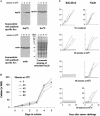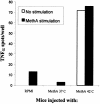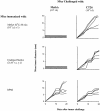The inducible Hsp70 as a marker of tumor immunogenicity
- PMID: 11599573
- PMCID: PMC434389
- DOI: 10.1379/1466-1268(2001)006<0121:tihaam>2.0.co;2
The inducible Hsp70 as a marker of tumor immunogenicity
Abstract
Growing evidence indicates that the stress response in general and heat shock proteins (Hsps) in particular have a profound impact on tumor immunogenicity. In this study, we show that tumor cells subjected to a nonlethal heat shock stress are unable to form tumors in syngenic mice, whereas they do so in athymic nude mice. Moreover, heat-shocked MethA immunity is tumor specific. Enhancement of T-cell-mediated immunogenicity correlates with the expression of the inducible Hsp70 but not the constitutive Hsc70. These observations have a bearing on the proposed functional role of Hsp-peptide association in antigen processing and presentation by major histocompatibility complex I molecules under normal and stressful conditions.
Figures



Similar articles
-
Co-segregation of tumor immunogenicity with expression of inducible but not constitutive hsp70 in rat colon carcinomas.J Immunol. 1995 Jul 15;155(2):740-7. J Immunol. 1995. PMID: 7608552
-
Selective depletion of inducible HSP70 enhances immunogenicity of rat colon cancer cells.Oncogene. 2001 Nov 8;20(51):7478-85. doi: 10.1038/sj.onc.1204948. Oncogene. 2001. PMID: 11709719
-
More efficient induction of HLA-A*0201-restricted and carcinoembryonic antigen (CEA)-specific CTL response by immunization with exosomes prepared from heat-stressed CEA-positive tumor cells.Clin Cancer Res. 2005 Oct 15;11(20):7554-63. doi: 10.1158/1078-0432.CCR-05-0810. Clin Cancer Res. 2005. PMID: 16243831
-
Message in a bottle: role of the 70-kDa heat shock protein family in anti-tumor immunity.Eur J Immunol. 2005 Sep;35(9):2518-27. doi: 10.1002/eji.200535002. Eur J Immunol. 2005. PMID: 16144035 Review.
-
Immunostimulatory functions of membrane-bound and exported heat shock protein 70.Exerc Immunol Rev. 2005;11:17-33. Exerc Immunol Rev. 2005. PMID: 16385841 Review.
Cited by
-
Heat shock protein derived from a non-autologous tumour can be used as an anti-tumour vaccine.Immunology. 2003 Sep;110(1):105-11. doi: 10.1046/j.1365-2567.2003.01726.x. Immunology. 2003. PMID: 12941147 Free PMC article.
-
Severe, but not mild heat-shock treatment induces immunogenic cell death in cancer cells.Oncoimmunology. 2017 Mar 31;6(5):e1311433. doi: 10.1080/2162402X.2017.1311433. eCollection 2017. Oncoimmunology. 2017. PMID: 28638734 Free PMC article.
-
Preparation of a heat-shock protein 70-based vaccine from DC-tumor fusion cells.Methods Mol Biol. 2011;787:255-65. doi: 10.1007/978-1-61779-295-3_19. Methods Mol Biol. 2011. PMID: 21898241 Free PMC article.
-
The Role of the NKG2D in Vitiligo.Front Immunol. 2021 Feb 26;12:624131. doi: 10.3389/fimmu.2021.624131. eCollection 2021. Front Immunol. 2021. PMID: 33717132 Free PMC article. Review.
-
Anti-tumor immune responses following neoadjuvant immunotherapy with a recombinant adenovirus expressing HSP72 to rodent tumors.Cancer Immunol Immunother. 2005 Oct;54(10):988-98. doi: 10.1007/s00262-005-0683-4. Epub 2005 May 12. Cancer Immunol Immunother. 2005. PMID: 15889253 Free PMC article.
References
-
- Asea A, Kraeft S-K, Kurt-Jones EA, Stevenson MA, Chen LB, Finberg RW, Koo GC, Calderwood SK. HSP70 stimulates cytokine production through a CD14-dependent pathway, demonstrating its dual role as a chaperone and cytokine. Nat Med. 2000;6:435–442. - PubMed
-
- Arnold-Schild D, Hanau D, Spehner D, Schmid C, Rammensee HG, de la Salle H, Schild H. Cutting edge: receptor-mediated endocytosis of heat shock proteins by professional antigen-presenting cells. J Immunol. 1999;162:3757–3560. - PubMed
-
- Basu S, Binder R, Suto R, Anderson KM, Srivastava PK. Necrotic but not apoptotic cell death releases heat shock proteins, which deliver a maturation signal to dendritic cells. Int Immunol. 2000;12:1539–1546. - PubMed
-
- Binder JR, Han DK, Srivastava PK. CD91: a receptor for heat shock protein gp96. Nat Immunol. 2000a;1:151–155. - PubMed
-
- Binder RJ, Anderson KM, Basu S, Srivastava PK. Heat shock protein gp96 induces maturation and migration of CD11c+ cells in vivo. J Immunol. 2000b;165:6029–6035. - PubMed
Publication types
MeSH terms
Substances
Grants and funding
LinkOut - more resources
Full Text Sources
Other Literature Sources
Miscellaneous
